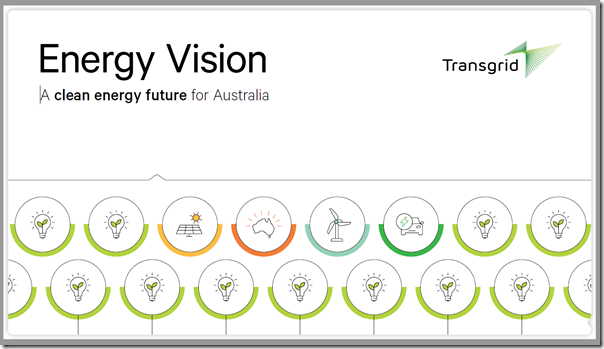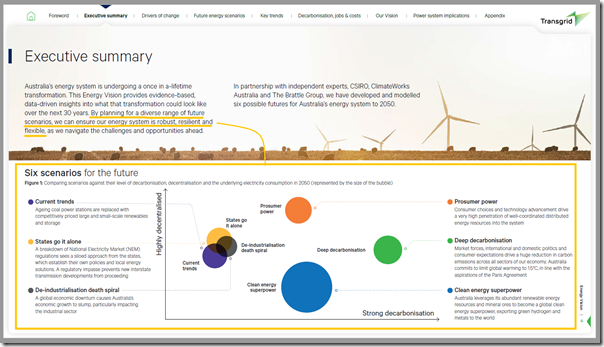Worth a short article this morning, as we may well be referencing back to this in future, to flag TransGrid’s release of what they call an ‘Energy Vision – A clean energy future for Australia’:
With my focus on our own upcoming GenInsights21 release (which I noted yesterday has been re-started now in Q4 for release on or around Monday 6th December 2021) I’ve not the time to delve in any detail.
However as time permits I might expand on what follows below…
(A) Discussion by TransGrid
The key point of the presentation seems to be that TransGrid (in conjunction with their collaboration partners CSIRO, ClimateWorks and Brattle Group) have modelled six different scenarios in terms of what might unfold into the future:
The reason they have done this seems to be summed up in this statement:
“By planning for a diverse range of future scenarios, we can ensure our energy system is robust, resilient and flexible, as we navigate the challenges and opportunities ahead.”
… with my emphasis added.
My interpretation is that TransGrid is not forecasting which scenario will unfold … with TransGrid’s need more fundamentally to understand a diverse range of possible future paths we might see the Australian electricity sector evolve down in future, because TransGrid needs to (somehow!?) be ready to serve under all of them.
Of course elsewhere we’ll no doubt see many individuals pick their own favourite scenarios (and no doubt there are people in TransGrid who also have favourites, for various reasons) – including other scenarios not modelled by TransGrid here (cue to those who support nuclear, for instance).
—
On the TransGrid website there is a media release entitled ‘Transgrid Energy Vision creates blueprint for Australia as a clean energy superpower – generating thousands of electricity jobs’ …. and there’s also a new blog article titled ‘Could Australia become a clean energy superpower?’.
(B) Coverage elsewhere
The first article I noted (published at 00:00 this morning ESDT) was Perry Williams’ article ‘TransGrid predicts early coal closures’ in the Australian. There’s two paragraphs worth noting:
Some 7 gigawatts of coal will exit the national electricity market by 2030 under current trends, 2GW more than anticipated, while a drive to deep decarbonisation would see the fossil fuel disappear from the system entirely by 2032 compared with the final coal plant exit date of 2048.
“The growth of renewables is challenging the economic viability of Australia’s ageing coal generators,” TransGrid said in its Energy Vision report to be released on Wednesday. “Our analysis indicates a high likelihood of early coal withdrawal across a range of future scenarios.”
Also quick off the mark, I noticed Sophie Vorrath wrote about the ‘Unstoppable transition – Australia can hit 91% renewables by 2030’, highlighting one of the six scenarios (i.e. the one called ‘Deep decarbonisation’) provided in the TransGrid report. The note about ‘unstoppable transition’ came from the TransGrid report also (Key Insight #1/7 on page 5).
No doubt there will be other coverage I find later…




It is well overdue that someone publicly identifies that the option that “states go it alone” is a real possibility.
One of the 49 recommendations accepted as part of the 2017 Dr Finkel led Review into the Future Security of the National Electricity Market – Blueprint for the Future was Recommendation 7.3 which stipulated that:
By mid-2018, COAG leaders should agree to a new Australian Energy Market Agreement that recommits all parties to:
• Taking a nationally consistent approach to energy policy that recognises Australia’s
commitment in Paris to reduce emissions and governments’ commitment to align efforts
to meet this target with energy market frameworks.
• Notifying the COAG Energy Council if they propose to take a unilateral action that falls
within the scope of Australian Energy Market Agreement prior to taking the action.
• Within 28 days of notification, the Energy Security Board will provide advice to the
COAG Energy Council on the impacts of the proposed action taking into account the
objectives of Australian Energy Market Agreement.
Realise COAG Energy Council has been rebadged but it is effectively the same entity without the open communication to stakeholders. Maybe COAG members are using the rebadging as an excuse for missing by 3 years the mid-2018 timeframe for agreeing to a new Australian Energy Market Agreement. States going it alone is a real possibility.
This is a very thorough report almost as thorough as the ISP and coming to similar conclusions particularly if one uses the ISP step change scenario, which is actually my base case.
When ITK started formally forecasting electricity prices a few years ago and said our modelling was different to other approaches in that we just assumed there would be enough policy to get to 50% renewable by 2030 it wasn’t taken all that seriously. And our modelling probably still isn’t although I take it seriously myself. But the point is 50% renewable by 2030 (which includes hydro) is now pretty much base case.
The forecasts in these models are done to meet the reliability standard, and yet they produce reasonable electricity prices and none of them suggest you need nuclear or anything similar. That is one reason why I am so supportive of Matt Kean and the NSW approach. It is based on sound modelling and a proper business and execution approach. And it is done in the open with feedback and consultation at every stage.
Of course as every epidemiologist and many others will point out, modelling is a very error prone process and any good policy maker will not rely solely on models . Still it has to be done and its great to see this effort from Transgrid.
The problem with optimistic projections of RE penetration is that we are only just approaching the point where it matters whether the sun shines or the wind blows. When we lose some more conventional capacity the problem of windless nights will become real and we will have to confront the full cost of firming that has been carried by the coal power stations up to date. See the story of the frog and the scorpion!
https://newcatallaxy.blog/2021/09/25/the-real-cost-of-unreliable-energy/